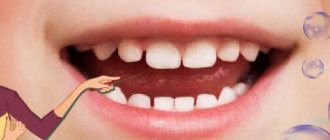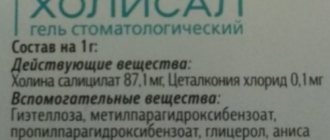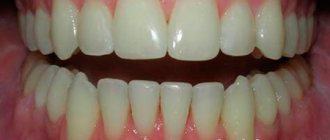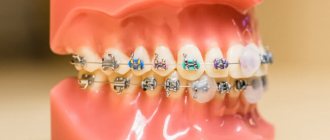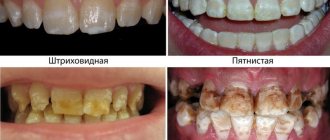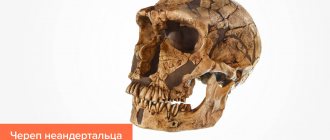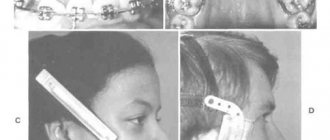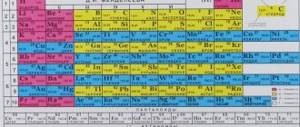Not every parent knows when baby teeth stop growing and permanent teeth begin to appear. The first canine appears before the baby is 6 months old, and by the age of 12 the child already has 28 radical units. But any person knows that a normal dentition should consist of 32 teeth. So, when do the eights cut through?
Each person develops a third molar at a different age. For some, it grows at 14 years old, for others at 30, and for some it does not appear at all. Knowing the age and characteristics of the eruption of baby and molar teeth, you can monitor the condition of the baby’s dental-jaw apparatus, ensuring the formation of a bite.
Until what age do baby teeth grow?
The first milk teeth (odontopagus) appear immediately after the baby is born. But there are cases when a child is born with teeth. In such a situation, this is considered an anomaly and they have to be removed. The formation of the dentition begins while the baby is in the womb, and by 6 months of life the first incisor appears.
Their eruption is accompanied by a number of unpleasant symptoms: pain, fever, swelling of the gums. Because of this, the baby becomes capricious, constantly cries and refuses to eat. During this difficult period, parents try their best to alleviate the baby’s suffering by using various ointments, creams, and drops.
A one-year-old baby has 6 dental units: 4 upper and 2 lower incisors, and by 36 months there are 20 primary odontopagus: 4 canines, 8 molars and incisors each. But even if by the age of 3 the child does not have these 20 units, then there is no need to worry, since each person is unique and teeth appear at an individual age. But the order of their growth is always the same. If by 36 months the baby does not have more than half the required number of odontopagus, then you need to consult a doctor.
The growth of primary teeth is influenced by the following factors:
- heredity,
- climatic living conditions,
- feeding habits of the baby, mother,
- hardness of consumed water,
- past illnesses,
- Lifestyle.
In the absence of pathologies, baby teeth stop growing by 20-40 months of a child’s life. The child should be shown to the dentist for the first time at the age of three, since it is during this period that the first dental problems begin to arise.
Problems with the eruption of baby teeth
Teething problems are often similar and can be solved through the efforts of those caring for the child. For example, to alleviate suffering, special teething toys are used. Some models of such toys are pre-cooled, creating an anesthetic effect. Massaging the gums with your index finger wrapped in a sterile gauze bandage also helps. Children also like to chew pieces of hard vegetables and fruits, but slices can be given for a short period of time and only under adult supervision.
Dentists believe that during this period, the children’s oral cavity already requires hygienic care, because after eruption, baby teeth are weak, porous and vulnerable. The first bite is cleaned with a silicone brush without the use of paste or with a gauze swab dipped in distilled water.
If the child is bothered by painful sensations, the pediatrician will recommend homeopathic remedies and gum gels with local anesthesia.
Parents should be wary if the appearance of a bite occurs with a significant delay. Sometimes this is due to heredity in the family, but it can also indicate rickets, a metabolic disorder or an infectious disease. Problems with the endocrine system are indicated by the appearance of a bite too early. If the teeth grow out of sequence, have an unusual appearance or do not appear at all, the doctor will find out the cause of the pathology and, if necessary, take an x-ray.
A number of oral diseases caused by decreased immunity deserve special attention:
- stomatitis;
- thrush;
- caries.
If you suspect an infection, you need to show your child to a doctor who will prescribe symptomatic treatment.
How are baby teeth replaced by molars?
The replacement of deciduous odontopagus with indigenous ones begins to occur at 6-7 years of age and ends at approximately 21 years of age. Although there are cases where a twenty-five-year-old person still had several milk teeth.
As molars grow, baby teeth begin to loosen and fall out. This process often does not cause severe pain or discomfort, but sometimes the milky odontopagus sits very tightly, which is why you have to remove it yourself or with the help of a dentist.
The replacement of teeth occurs gradually, in the same way as baby teeth appeared.
The first permanent chewing unit is the first molar, which arises behind the last primary tooth. Then, at the age of 6-9 years, the incisors and first molars are replaced, and at the age of 9-11, the molars and premolars appear. The entire process of replacing teeth is completed by the age of 12, but slight deviations from the norm are possible.
At what age do wisdom teeth grow in?
"Eight" does not grow in all people. Experts believe that if the jaw is too narrow, the rudiments of the third molars do not appear, because there is not enough space for them. There is also a version that they can grow at an incorrect angle, which is why they do not appear on the surface. In some situations, a molar may only partially erupt, while part of it remains in the gum.
The timing of the eruption of the “eight” may vary. Some people begin to grow wisdom teeth at age 17. Most often, by the age of 25-30 the process should be completed, all 4 molars should appear on the surface.
There are however exceptions. Some people notice the beginning of the eruption of “eights” after 40 years. Hormonal surges can affect growth and development. Often their appearance is noted by pregnant women, those who had an abortion, girls who gave birth in the recent past.
The appearance of wisdom teeth is often accompanied by intense pain. The bone tissue of an adult is formed; it is not easy to “break through” it. If growth began in adolescence, symptoms will be less pronounced. The older a person is, the more difficult it is for him to experience the teething of “eights.” The state of health worsens, the body temperature rises, and headaches occur.
Until what age do molars grow?
It is impossible to say exactly when molars stop growing. By about 10-12 years of age, a child has 28 permanent teeth, although their formation can take much longer. Much later than the others, the third molars appear, or as they are usually called, wisdom teeth. There is no specific age for eruption of these odontopagus.
Ideally, they should appear between the ages of 17 and 25, but this can happen much later. It is not uncommon for 3 molars to erupt at 30, 40 or even 70 years of age. And sometimes they don’t appear at all (retired wisdom teeth). The process of growth of figure eights is often accompanied by severe pain, increased body temperature, and swelling.
In addition, the appearance of molars is often accompanied by abnormalities in growth or location, which is why it is often necessary to get rid of them. Their eruption occurs over many years, followed by periods of active growth and dormancy. Sometimes the tooth never fully grows in and remains in the jaw. To the question: “Until what age do molars grow?”, some doctors answer: “Up to 30 years.”
But most specialists are not able to provide an accurate answer, since, depending on heredity and the influence of external or internal factors, the process of growth of molars can last throughout life. Do you feel nervous before visiting the dentist?YesNo
There are cases when at 70-80 years old, after all the teeth have fallen out, they begin to grow again. So, everything is purely individual.
General principles of growth
Baby teeth begin to grow from 6-8 months of age. As a rule, by the first anniversary of his life, the baby has already “acquired” four upper and lower units. By the age of 2 years, the first canines and molars “come into the world”; after another six months, the second molars are added. The final appearance of the primary dentition (20 units) can be observed in three-year-old children.
Read also: Wisdom tooth injures cheek
What to do if by 9 months the baby has not yet acquired a single tooth:
- carefully examine the oral cavity; the gums, as a rule, look slightly swollen and reddened; upon palpation, the tooth edge can be felt;
- in order to speed up the process of “birth” of the first units, pediatric dentists recommend that young parents purchase growth stimulants for baby teeth at the pharmacy - rubber ring toys;
- A light massage of the gums with a clean finger or a cold tablespoon will also only benefit the baby.
In the latter case, parents should seek help from a pediatrician - perhaps he will prescribe vitamins or calcium supplements to the child to normalize “healthy” mineral metabolism and improve metabolism in general. In rare cases, the absence of signs of teething up to a year indicates edentia (the rudiments of the milk units have simply not formed). In such a situation, the help of a pediatric dentist is required - he will send the child for an x-ray, based on the resulting image, he will make a diagnosis and select treatment.
To what age do a person’s teeth grow: throughout life, 20 units are replaced at a time (deciduous – permanent), and 8–12 units initially grow as molars. General cutting scheme:
- medial lower incisors – 6–9 months;
- medial upper incisors – 7–10 months;
- lateral upper and lower incisors – 9–12 months;
- first upper permanent teeth – 12–18 months;
- first lower molars – 13–19 months;
- upper (16–20 months) and lower (17–22 months) canines;
- second lower (20–33 months) and upper (24–36 months) root units.
These figures are very relative; it all depends on the individual characteristics of a particular organism. As a rule, by the age of 3, a child has already grown all his milk teeth, and from the age of 5 they begin to gradually be replaced by molars. Why teething may be disrupted: type of feeding (instead of breastfeeding - artificial), genetic factors, loss of baby teeth due to dental problems.
Stages of bite formation
The formation of the bite - the position of the teeth with the jaws closed, occurs from birth until the age of 18, going through several stages:
- From birth to 6 months. There are no teeth, but the jaws are actively developing. It is very important to breastfeed your baby during this period and ensure that he holds his head correctly.
- From 6 to 36 months – all baby teeth appear. Parents should ensure that the baby does not suck his finger or any objects. The constant presence of an object in the mouth leads to displacement of the dentition and the formation of gaps.
- From 3 to 6 years - preparation for the growth of molars, active growth of the jaws. At this age, jaw anomalies are clearly visible. If the upper jaw protrudes significantly above the lower jaw, you need to give the child solid food. You can use removable braces.
- From 6 to 12 years – growth of permanent odontopagus. At this time, you need to especially monitor the formation of your bite. It often happens that the baby teeth have not yet fallen out, but the molars have already come out. To straighten the bite, it is necessary to remove excess units.
- From 12 to 18 years – completion of tooth growth, completion of bite formation.
Throughout all stages, parents should monitor the correct positioning of the baby’s jaws, observing the formation of the bite. And if it is incorrect, then before the end of the last stage, the bite can be corrected without surgical intervention. The best period for correcting the abnormal position of the jaws is the age of 11-13 years.
Start and end of the process
The baby's molars begin to develop in the womb at 8-9 months of pregnancy. The first permanent teeth appear when the baby is 6 months old. At one and a half years old, the central molars begin to erupt.
After a year, the side ones appear. If the baby is already 5 years old, get ready for the fact that baby teeth will soon begin to fall out, and molars will grow in their place. Most of them are formed before the age of 10.
Already at a fairly mature age, wisdom teeth usually erupt. Often, for its final appearance, the help of a surgeon is used.
At what age does bite formation stop?
Often, when replacing primary odontopaguses with permanent ones, a malocclusion occurs, which can be corrected if you consult an orthodontist in a timely manner. The timing of the formation of a permanent dentition is ambiguous. Normally, its formation occurs by adulthood, but sometimes this process drags on for many years.
The formation of a bite depends on many factors: heredity, climatic conditions, nutrition, water quality and much more. By 30 months, a temporary position of the jaws is formed, which is replaced by a permanent bite in the period from 6 to 14 years.
In order for the child to have the correct position of the jaws, it is necessary to monitor the formation of the main and temporary bite, visit the dentist and orthodontist.
How do “eights” erupt?
It is impossible to give an unambiguous answer to the question of when wisdom teeth begin to grow and until what age do they grow. Third molars “come into the world” in the period from several months to 2-3 years, causing a lot of unpleasant sensations. When the “eights” begin to grow is influenced by many factors - in particular, the number of bone buds, heredity, and the anatomical features of the jaw (its shape). Due to the fact that third molars often create a certain discomfort - they affect the functioning of the TMJ, provoke sinusitis, and “displace” neighboring units of the dentition - they are often removed.
Read also: How long do wisdom teeth grow?
The main indications for extraction are:
- persistent hyperthermia (2–3 days) during the growth of wisdom teeth;
- acute inflammation of the gums (gingivitis) at the site of eruption;
- severe pain that makes eating difficult.
When do babies' first teeth begin to erupt?
Very often, teething in children is accompanied by unpleasant moments. The task of adults is to facilitate this process and notice violations in time.
Dates of appearance
All children develop their first teeth differently and at different times. This depends on many factors: heredity, diet, climate. How many months does the first tooth appear? Most often, teeth begin to cut by 6-8 months. By the age of one year, a child has about 8 baby teeth in his mouth. How many baby teeth do children have? By age 3 there should be 20 teeth.
Parents begin to panic when there are no teeth before the ninth month. Usually this is not associated with anything serious, but it would be a good idea to see a dentist. The timing may shift due to general underdevelopment of the body due to diseases (for example, rickets). Your doctor may recommend taking vitamins and minerals.
When a child's teeth are teething, parents should be wary of the following points:
- A very rare disease is edentia - the absence of tooth buds. The examination is carried out if the child is one year old and has no teeth. An x-ray of the gums is taken.
- The appearance of the first teeth too early (before the 4th month) may indicate disturbances in the endocrine system.
- If a baby's teeth erupt in the wrong sequence, the reasons should be sought during pregnancy (previous diseases, threats).
- Additional examination to establish a diagnosis is necessary if the teeth are of irregular shape, color, size, or position.
If teeth are cut at 3-4 months, this should not be a big concern.
Most often, they begin to grow early as a result of taking calcium, vitamin D and fermented milk products during pregnancy.
If a child’s tooth begins to erupt at 2 months, parents need to know how to relieve pain and reduce unpleasant symptoms. At 2 months, the body is not yet strong, the internal organs have not adapted to the new environment. Therefore, the symptoms may be more pronounced. Not all medications are allowed at this age.
The appearance of teeth has a certain order. Adults need to know which ones appear first.
The order of teeth growth is determined by nature, and looks like this:
- The two lower central incisors appear first. They can be cut simultaneously or separately.
- After a couple of months, the upper central incisors begin to appear.
- Next come the second pairs of upper and lower incisors.
- Then two upper and two lower fangs.
- Behind them are the upper and lower pair of first molars.
- Then the upper and lower pair of second molars.
| Name of baby teeth | Approximate eruption time |
| Central incisors | 6-12 months |
| Lateral incisors | 7-16 months |
| Fangs | 7-16 months |
| First molars | 1-2 years |
| Second molars | 2-3 years |
The correct order of teething indicates the overall health of the child. Sometimes the order changes, this happens as a result of individual characteristics. In this case, the schedule for the eruption of all teeth may change.
When one tooth of a pair has erupted, but the second has not, while others are being cut, you need to contact a specialist to rule out an anomaly.
The timetable for the loss of baby teeth is always the same. Usually, the order in which they appear is the order in which they appear.
Teething in infants is accompanied by a number of changes in behavior and health. The body's reaction may vary.
An adult can easily determine that teeth are being cut by looking into the child's mouth. The main local symptoms include redness, inflammation, and swelling of the gums. From this moment until the tooth begins to cut, it may take 1 month or even more. The child's behavior also changes.
Common signs include:
- the child becomes capricious and excitable;
- often wakes up in the middle of the night crying;
- loss of appetite until complete refusal to eat;
- all toys and other objects end up in the baby’s mouth;
- salivation increases. Saliva can irritate the skin of the face, causing a rash;
- when teeth are being cut, redness and rash can be observed on the cheeks of infants at this moment;
- sometimes the body temperature rises to 38 degrees, if there is no yellow or green snot or dry cough, then this is a normal reaction of the baby’s body.
Kinds
There are temporary (milk), mixed and permanent dentition, each of which has its own characteristics and time frame.
- Temporary or primary dentition refers to the period from the appearance of the first primary teeth to the beginning of their replacement.
- Mixed bite involves the simultaneous presence of both primary and molar teeth; this can usually be observed from 5-6 to 10-12 years.
- A permanent bite, as a rule, is formed by 12-14 years, although the jaw structure is finally formed after 20 years.
A permanent bite is formed by the age of 12-14.
Thus, there are 3 main types of bite, and each period can be divided into separate time periods.
Peculiarities
The process of eruption of teeth in the oral cavity in humans occurs during the childhood period of development, but the exception is wisdom teeth. The late appearance determines their very name. The question of when and until how many years wisdom teeth grow has not been fully studied at present, and dentists cannot give an exact explanation and reason.
Some people may have four units erupting at the same time, while others will have none. Each person has a completely different timing of appearance, which is determined by their location. The reason is that, with rare exceptions, they are positioned correctly during active growth.
Basically, wisdom teeth, or as dentists also call them third molars, during development have anomalies in location or direction of growth, causing unpleasant sensations.
Often their growth occurs at the wrong angle in relation to other dental units, the jaw, and they can also rest against neighboring roots or cheeks. Long before they appear, there is pain in the gums, and swelling is observed in the areas of eruption. Why this happens may also depend on factors such as anatomical structure.
The timing of the appearance of wisdom teeth is completely different for each person.
Wisdom teeth do not differ from others in appearance, but they differ in structure. It is worth noting that rooted permanent teeth are finally formed by adolescence with one root. And wisdom teeth, which can only erupt from this period and usually grow in pairs, have from one to five roots fused together into one. There are often bends in the root canals that interfere with treatment and require surgical intervention.
Read also: Wisdom tooth hood
Need for removal
Wisdom tooth growing to the side
Along with the question of how old a wisdom tooth grows, many people are concerned about the need to remove a wisdom tooth if problems or pain arise with its eruption. There are certain indications for surgical intervention that dentists warn about:
- impacted wisdom tooth, which means it is not positioned correctly in the jaw. It will not be able to erupt due to partial or complete contact with adjacent teeth;
- impossibility of filling due to inaccessible location;
- the process of long teething can provoke the development of caries;
- partial eruption, which results in an inflammatory process with pain;
- pain in the trigeminal nerve;
- the appearance of a cystic formation in the lower jaw;
- pain in the head, during swallowing, other painful conditions;
- permanent injuries to the mucous membrane.
It should be noted about the consequences of removal, which is primarily associated with injury to the jaw with slow wound healing and complications. After removal, aching pain may be present, which indicates inflammation of the hole. The normal healing process occurs by covering the hole with a blood clot, protecting it from germs.
After removal, do not rinse, as washing out the clot leads to infection. As a result, repeated surgical intervention may be required, especially in cases of numbness of the tongue, lips, or chin, which does not go away for a long time.
Wisdom tooth removal
In conclusion, we note that rapid teething reduces the development of inflammation. And the long growth process is fertile ground for the accumulation of bacteria and the development of various dental diseases. The question of the time and age at which a wisdom tooth grows depends on the individual characteristics of the anatomical structure of the jaw, genetic heredity, as well as the sufficiency of space in the dentition.
What problems may arise during the period of teeth change?
Many problems can arise when children lose their molars. The most common complications include:
- Lack of permanent teeth.
- Growth of a permanent tooth before the loss of a temporary one.
- Pain in a molar tooth.
- Molar tooth loss.
For every case, dentists have a solution; you just need to detect the problem in time and seek help. The last two phenomena arise due to low mineralization of hard tissue, and such anomalies appear regardless of how old the molars are.
It is necessary to teach a child to take care of the oral cavity from a very early age. By the time the bite changes, he should already be able to use a brush and paste. During the germination of molars, other recommendations must be followed:
- It is better to use pastes with increased amounts of calcium and fluoride.
- Make sure your child regularly uses antiseptic mouth rinses.
- It is worth limiting the amount of sugar your child consumes, as it leads to the development of caries. When children's molars are just cutting in and have not yet had time to get stronger, the disease can develop in just a few weeks.
- Include more fruits, vegetables, and dairy products in your diet. All of them have a positive effect on oral health.
- Do not limit your child to hard foods; they massage the gums and improve the growth of hard tissue.
- Consult with your pediatrician and together with him select a complex with a high content of vitamin D, which improves the absorption of calcium.
- Try to show your baby to the dentist for the first time no later than 3–4 years old. When the first molars begin to emerge, the child should no longer be afraid of the dental office, since he will have to visit a specialist very often.
The health of your child’s baby teeth should not be left to chance, and certainly not ignored when a permanent bite begins to form.
In 10–20% of cases, children and parents encounter some difficulties when changing a baby jaw to a permanent one. Common problems include:
- Hyperdontia, or shark jaw. The teeth grow in two rows. The milk ones don’t fall out, but the permanent ones break through and stand behind. In case of such pathology, consultation with a doctor is necessary immediately. An extra row prevents teeth from developing properly, causing the jaw to become crooked.
- Extensive hematoma at the eruption site. A red or bluish bubble forms. The gums hurt, it interferes with chewing and speaking. Parents can numb the process with Kalgel or Kamistad.
- Negative reaction of the whole body. A preschooler feels like a baby when his first teeth appear. The temperature rises, there is a cough, snot, diarrhea begins, the mouth hurts, the gums become inflamed, the emotional background is unstable, sleep is disturbed. Give your child Dentokind. It has a calming effect and relieves the main symptoms of illness.
Complications
Wisdom tooth eruption
The most common complications during growth in people are inflammatory processes in the gums in the tissues located near the tooth. During its growth, a tubercular formation appears on the surface of the gum, covered with a mucous membrane (hood). This place is susceptible to injury, mechanical damage from eating solid food, which subsequently affects the active development and proliferation of harmful microorganisms, bacteria and suppuration.
Such formations are a sign of pericoronitis - a disease that begins with minor pain in the area where the figure eight erupts. With the further development of inflammation, the pain begins to intensify, radiating to the temples, ears, when swallowing, and opening the mouth. Possible pain in the facial muscles, inflammation of the trigeminal nerve, lymph nodes, sometimes even a fever, headache. Swelling and redness in the area of the formed hood is accompanied by the release of pus.
In this case, it is necessary to urgently consult a doctor, take a picture of the area, carry out treatment or remove it in a timely manner to prevent complications.
When treating pathologies, dentists open the mucous membrane, rinse the cavity and prescribe anti-inflammatory drugs. In most situations, in case of repeated inflammation, it is necessary to remove the unit that has not yet appeared. Another common problem during the teething process is the appearance of caries.
Read also: What to do when your wisdom tooth hurts
The main reason for the appearance of the disease is associated with poor hygiene in the hard-to-reach place of development of the figure eight, and from a tight fit the disease quickly spreads to adjacent teeth.
If there are no external signs of inflammation, it is necessary to take a picture in order to know in advance about the correct growth of the tooth and the need for its removal.
Growth of milk units
How to find out that your baby is getting his first teeth:
- the gums become red, swell, a white ball can be visually identified, from which the milk unit will later “be born”;
- the child’s cheeks are burning;
- the baby becomes capricious, whiny, refuses to eat and sleeps poorly, and the body temperature may “jump” slightly.
Increased excitability is another “identifying sign” of the onset of teething. The child begins to put foreign objects into his mouth - chewing minimizes discomfort on the oral mucosa. A typical symptom is increased salivation - when the secretion gets on the skin of the face (in the cheeks, chin), it causes the appearance of foci of irritation (rash). Many parents notice limited hyperemic areas on the child’s neck (on the side where the tooth is cut).
Teething is a difficult period for a child’s body; against the background of restructuring and weakened immunity, children can be “attacked” by ARVI. So, if a child has attacks of nausea and vomiting, cough, abdominal pain, runny nose, appetite has disappeared or the body temperature has risen, it is recommended to immediately show him to a pediatrician.
Important: you should not additionally stimulate (try to speed up) the process of eruption of baby teeth. Some parents scratch their gums with bread crust, a piece of sugar, and other irritants. Such measures will not have any effect on the “birth” of milk units, but they can provoke injuries to the oral mucosa or “contribute” to the development of a local inflammatory process.
Read also: Swollen gums between teeth
